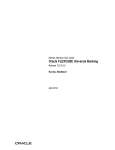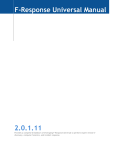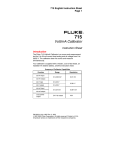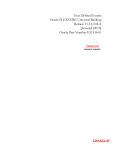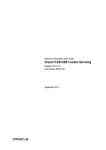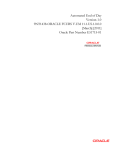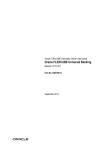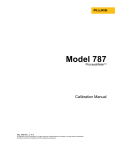Download Mantas Interface User Manual
Transcript
Mantas Interface Oracle FLEXCUBE Universal Banking Release 11.3.83.02.0 [April] [2014] Oracle Part Number E53607-01 Mantas Interface Table of Contents 1. ABOUT THIS MANUAL................................................................................................................................ 1-2 1.1 INTRODUCTION ........................................................................................................................................... 1-2 1.1.1 Audience ............................................................................................................................................ 1-2 1.1.2 Acronyms and Abbreviations ............................................................................................................. 1-2 1.1.3 Organization ...................................................................................................................................... 1-2 1.1.4 Related Documents ............................................................................................................................ 1-3 2. ORACLE FLEXCUBE – MANTAS INTEGRATION................................................................................. 2-1 2.1 INTRODUCTION ........................................................................................................................................... 2-1 2.2 MAINTAINING DETAILS FOR DATA HAND-OFF TO MANTAS ....................................................................... 2-1 2.2.1 Maintaining Mantas Installation Parameters.................................................................................... 2-1 2.2.2 Viewing the Mantas Code Parameter Details.................................................................................... 2-3 2.2.3 Maintaining Data File Parameters.................................................................................................... 2-3 2.2.4 Maintaining Frequency and Hand-Off Type Parameters .................................................................. 2-7 2.2.5 Maintaining Branch Parameters ....................................................................................................... 2-8 2.2.6 Specifying the Data Extraction Details.............................................................................................. 2-9 2.2.7 Maintaining UDF-s ......................................................................................................................... 2-10 2.3 CAPTURING COUNTRY INFORMATION ...................................................................................................... 2-10 2.3.1 Maintaining Customer Account ....................................................................................................... 2-11 2.3.2 Maintaining Ultimate Beneficiary Details....................................................................................... 2-11 2.3.3 Instrument Transaction Details ....................................................................................................... 2-11 2.3.4 Funds Transfer Transaction Details................................................................................................ 2-11 2.3.5 Clearing Transaction Details .......................................................................................................... 2-11 2.3.6 TD Redemption/Renewal ................................................................................................................. 2-11 2.3.7 PC Transaction Input....................................................................................................................... 2-11 2.3.8 Settlement Instructions..................................................................................................................... 2-12 2.4 PERFORMING THE DATA HAND-OFF ......................................................................................................... 2-12 2.4.1 Reference Data ................................................................................................................................ 2-12 2.4.2 Transaction data.............................................................................................................................. 2-13 2.4.3 Change Log...................................................................................................................................... 2-13 2.4.4 Extracting the Batch Data ............................................................................................................... 2-13 2.4.5 Writing the Batch Data .................................................................................................................... 2-13 2.5 FILE NAMING CONVENTION AND FILE FORMATS...................................................................................... 2-13 2.6 DATA TYPES ............................................................................................................................................. 2-14 3. KYC (KNOW YOUR CUSTOMER) ............................................................................................................. 3-1 3.1 INTRODUCTION ........................................................................................................................................... 3-1 3.1.1 File Formats ...................................................................................................................................... 3-1 3.1.2 Maintaining Mantas Response........................................................................................................... 3-1 3.1.3 Viewing the Summary Details of Mantas Response Maintenance ..................................................... 3-2 3.1.4 Uploading Mantas Response ............................................................................................................. 3-3 3.1.5 Viewing the Risk Score ...................................................................................................................... 3-4 4. SCREEN GLOSSARY .................................................................................................................................... 4-1 4.1 FUNCTION ID LIST...................................................................................................................................... 4-1 1-1 1. About this Manual 1.1 Introduction This document is designed to help you acquaint with the enhancements and changes provided in Oracle FLEXCUBE to interact with Mantas, an AML application. This manual explains the various maintenances required for the exchange of data between Oracle FLEXCUBE and Mantas to track money laundering activities. It also gives you an insight into the type of data to be transferred to Mantas to perform AML activities. Besides this User Manual, while maintaining the interface related details, you can invoke the context sensitive help available for each field. This help encapsulates the purpose of each field within a screen. Placing the cursor on the relevant field and striking the <F1> key on the keyboard can obtain information specific to a particular field. 1.1.1 Audience This manual is intended for the following User/User Roles: Role Function Back office data entry Clerks Input functions for maintenance related to the interface Back office Managers/Officers Authorization functions 1.1.2 Acronyms and Abbreviations Abbreviation Description System Unless and otherwise specified, it shall always refer to Oracle FLEXCUBE Corporate (FCC) system AML Anti Money Laundering UDF User Defined Field BIC Bank Identification Code 1.1.3 Organization This manual is organized into the following chapters: Chapter 1 Oracle FLEXCUBE-Mantas Integration —talks about the maintenances required for exchanging data to Mantas, the hand-off files, and batch process for extracting and writing the hand-off data. Chapter 2 Annexure – explains the file formats and the data types used in the data hand-off. 1-2 1.1.3.1 Conventions Used in this Manual Important information is preceded with the symbol. 1.1.4 Related Documents You may need to refer to any or all of the User Manuals while working on the Mantas Integration interface module: CASA Core Entities Clearing Funds Transfer Settlements Payments and Collections Standing Instructions Term Deposits Utility Payment Salary Processing ATM/POS Transactions Liquidity Management 1-3 2. Oracle FLEXCUBE – Mantas Integration 2.1 Introduction Money Laundering is the process of moving illicit funds through the banking system so as to disguise the origin of the funds. Anti money laundering applications, based on the data from the banking system, tracks and identifies patterns in the banking transactions to trace any possible fraud or money laundering involved. AML systems also attempt to detect money laundering activities by analyzing the changes in specific customer/account information and the transactions performed on an account. Mantas is an AML system which monitors the money flowing into and out of the banking system to detect possible money laundering. An interface between Oracle FLEXCUBE and Mantas enables data hand-off from Oracle FLEXCUBE to Mantas. To perform AML monitoring, Mantas requires reference data relating to the customer, accounts etc. as well as transaction details related to customer accounts. 2.2 Maintaining Details for Data Hand-Off to Mantas You need to maintain the following details to enable the data hand-off to Mantas: Mantas Installation parameters Mantas Data file parameters Frequency and Hand-off type parameters Branch parameters UDF-s related to customer, account and user In addition to the above maintenances, you need to capture the country information in the following screens: Customer Account Maintenance Ultimate Beneficiaries Instrument Transaction Details Funds Transfer Contract Details Clearing Transaction Input TD Redemption/Renewal PC Transaction Input Settlement Instructions Each of these maintenances is discussed in detail in the following sections of this Manual. 2.2.1 Maintaining Mantas Installation Parameters You can capture the details specific to the Mantas installation in the ‘Mantas Code Parameters’ screen. 2-1 To invoke the installation parameters screen from the Application Browser, select ‘Install Parameters’ under ‘Mantas’ in the ‘Interface’ module. You can capture the following details in this screen: Mantas Code Specify the Mantas Code which identifies the Mantas instance to which the Oracle FLEXCUBE physical instance is mapped. Description Specify the description for the Mantas installation. File Write Destination Specify the pre-defined destination, where Oracle FLEXCUBE will place the hand-off file. Mantas will pick up the hand-off file from this destination. File Write Batch Name Specify a pre-defined name for the file batch which will be a part of the hand-off file name. This pre-defined string should be unique across all Mantas codes to which the bank is handing-off files. Base Currency Select the base currency into which the amount involved in a transaction has to be converted to be sent to the hand-off files. There can be only one base currency associated with a Mantas Code. 2-2 Rate Code The rate codes are maintained by Oracle FLEXCUBE for a base and reporting currency pair. Select the Rate Code to be used for the base and reporting currency conversions. Rate Code Type Select the Rate Code Type that specifies if it is a Buy rate, Sell rate, or Mid rate. This will also be used in the base and reporting currency conversions. 2.2.2 Viewing the Mantas Code Parameter Details You can view the Mantas code parameter details in ‘Mantas Code Parameters Summary’ screen. To invoke this screen type ‘IFSMTSCD’ in the field at the top right corner of the Application tool bar and click the adjoining arrow button. In this screen, you can query based on any combination of the following fields: Authorization Status Record Status Mantas Code File Write Batch Name After specifying the parameters for the query, click ‘Search’. The system displays all the records matching the parameters specified. 2.2.3 Maintaining Data File Parameters You can maintain the file parameters for the following types of data: Reference Data file parameters Transaction Data file parameters Change Log file parameters 2-3 These parameters can be captured using the ‘Mantas File Parameters’ screen. You can invoke the ‘Mantas File Parameters' screen by typing 'IFDMTSFP' in the field at the top right corner of the Application tool bar and clicking the adjoining arrow button. You can capture the following details here: Bank Code The Bank Code will be defaulted from the Bank maintenance. Source ID Specify the Source ID, which is a unique identifier representing the Oracle FLEXCUBE instance which hands-off data to Mantas. The Source ID can be only three characters long. 2.2.3.1 Specifying Reference Data file Parameters Reference data file parameterization provides the bank an option to include or exclude a particular data file in the data hand-off. 2-4 You can capture the following details here: File Name This provides a list of all the reference data files. Option You can specify whether you want to include or exclude a particular data file for the data hand-off. 2-5 2.2.3.2 Specifying Transaction data file parameters Transaction data file parameterization provides the bank an option to choose the type of transactions to be included in the transaction hand-off files. You can specify the following details here: Transaction Type The different transaction types with the corresponding modules, which qualify for hand-off, are listed out. Option You can specify whether you want to include or exclude a particular transaction type for the handoff. 2-6 2.2.3.3 Specifying Change Log File Parameters Change Log file consists of modified data of specific fields relating only to Account, Account Address, Customer, and Account to Customer entities. Change Log parameterization provides the bank an option to include or exclude an entity in the Change Log hand-off file. You can specify the following details here: Entity The list of the entities which qualify for hand-off, are displayed. Option You can specify whether you want to include or exclude a particular entity for the hand-off. 2.2.4 Maintaining Frequency and Hand-Off Type Parameters Frequency and hand-off type parameterization provides the bank the option to choose the frequency and the type of hand-off. This option is available only for the hand-off files related to Reference Data. Frequency and/or hand-off type parameterization will not be available for Change Log and Transaction hand-off files. You can specify these details in the ‘Mantas Handoff Parameters’ screen. You can invoke the ‘Mantas Handoff Parameters' screen by typing 'IFDMTSFH' in the field at the top right corner of the Application tool bar and clicking the adjoining arrow button. 2-7 You can capture the following details in this screen: Bank Code The Bank Code is defaulted from the Bank maintenance. File Name This is the name of the hand-off data file. All the hand-off files related to Reference data type are displayed. Frequency This is the handoff frequency type. The frequency value will be displayed as ‘As Needed’ for the Country and AccountCustomerRole files. All the other files will have the frequency set as Daily. Extract Type Specify the type of extract for the handoff, indicating whether a file is to be sent as Full or Incremental. For files with frequency specified as “As needed”, the extraction type will always be Full. A Full extraction takes place only if any modification happens to the data. If there are no modifications for a day, no file will be handed off for that day. For all other frequencies, an empty file would be handed off for the day, if there is no data for hand-off. 2.2.5 Maintaining Branch Parameters Every branch of a bank extracts the reference and the transaction data for itself and writes the data into a data store, as one of its mandatory pre-EOD programs. Only one branch will be designated to write the hand-off file on behalf of all the other branches and itself, for a particular Mantas code. The Extraction and the File Write roles can be assigned to the branches using the ‘Mantas Branch Parameters’ screen. 2-8 You can invoke the ‘Mantas Branch Parameters' screen by typing 'IFDMTSBR' in the field at the top right corner of the Application tool bar and clicking the adjoining arrow button.. You can specify the following details in this screen: Branch Code The Branch Code will be defaulted from the logged in branch. Description The description for the branch is also defaulted from the Branch maintenance. File Write Role Check this option to specify that file write role should be designated to write the extracted data on behalf of all the other branches and itself.. Mantas Code Select the Mantas Code corresponding to the branch, from the option list provided. 2.2.6 Specifying the Data Extraction Details In the ‘Data Extraction Monitor’ screen, you can specify details pertaining to data extraction. To invoke this screen type ‘IFDMTSEM’ in the field at the top right corner of the Application tool bar and click the adjoining arrow button. 2-9 You can specify the following details: Branch Code Select the branch code which has got the file write role from the list of options. Click ‘Refresh’ button to view the extraction status pertaining to the branch. The status will be ‘C’ or ‘N’ which indicates the ‘completed’ and ’not completed’ status of data extraction. Note the following: The ‘Data Extraction Monitor’ screen is accessible only to the branch which has file write role and an error message is displayed if it is accessed from other branches. o By default, all the branches will have extraction role once the branch is saved using the branch parameter screen. Further, one of the branches will be given the file write role. 2.2.7 Maintaining UDF-s Specific attributes related to a Customer, Account and Oracle FLEXCUBE User need to be provided to Mantas in the corresponding files. The following User defined fields will be maintained for Account, Customer and Oracle FLEXCUBE user: MNTS_BUS_DOMAIN which indicates the Mantas business domain MNTS_JURISDICTION which indicates the Mantas jurisdiction The extraction will pick up these values from the Customer, Account, and User maintenances and provide the same in the corresponding field for the relevant file. 2.3 Capturing Country Information The country location involved in a transaction is crucial for Mantas to analyze the transactions. The following input screens in Oracle FLEXCUBE have been modified to capture the country information. This information capture is only for Mantas handoffs and will not have any other impact. 2-10 2.3.1 Maintaining Customer Account You need to capture the country information of the customer account in the ‘Customer Accounts Maintenance’ screen. For more details, refer to the section ‘Maintaining Customer Accounts’ in the Core Entities User Manual. 2.3.2 Maintaining Ultimate Beneficiary Details You need to capture the country location of the ultimate beneficiary in the ‘Ultimate Beneficiaries’ screen. For more details, refer to the section ‘Maintaining ultimate beneficiary details’ in the Settlements User Manual. 2.3.3 Instrument Transaction Details You need to capture the country location of the remitter in the ‘Instrument Transaction Details’ screen. For more details, refer to the section ‘Entering Instrument Transactions’ in the CASA User Manual. 2.3.4 Funds Transfer Transaction Details You need to capture the country location of the ordering customer, the ultimate beneficiary and the account with institution in the ‘Funds Transfer Contract Details’ screen. For more details, refer to the section ‘Invoking the FT Contract Detailed Screen’ in the Funds Transfer User Manual. 2.3.5 Clearing Transaction Details You need to capture the country location of the remitter and the beneficiary in the ‘Clearing Transaction Input’ screen. For more details, refer to the section ‘Entering Clearing Transactions’ in the Clearing User Manual. 2.3.6 TD Redemption/Renewal You need to capture the country location where a check is issued in the ‘TD Redemption/Renewal’ screen. For more details, refer to the section ‘Maintaining details for redeeming term deposits’ in the Core Entities User Manual. 2.3.7 PC Transaction Input You need to capture the country location of the customer and the counterparty in the ‘PC Transaction Input’ screen. 2-11 For more details, refer to the section ‘Capturing the details of payment/collection transactions’ in the Payments and Collections User Manual. 2.3.8 Settlement Instructions You need to capture the country location of the following parties in the ‘Settlement Instructions’ screen. Intermediary Intermediary Reimbursement Institution Receiver’s Correspondent Account with Institution Receiving Intermediary Beneficiary Institution Beneficiary Institution for Cover For more details, refer to the section ‘Capturing Settlement Preferences for a Customer’ in the Settlements User Manual. 2.4 Performing the Data Hand-Off The extraction of the data at the various branches and the writing of the hand-off file data are handled through batch processes. The data files handed off to Mantas can be broadly classified as follows: Reference Data Transaction Data Change Log 2.4.1 Reference Data Reference Data consists of the details related to the following entities. Account - the details of all the accounts of type Nostro, Savings, Current, and Deposits AccountAddress - the address details associated with an account AccountToCorrespondent - the details of all the accounts of type Nostro and Current related to banks only AccountBalance - the account number and the current available balance AccountCustomerRole - the different roles of a customer which can be (primary/secondary/partner/etc) associated with an account AccountToCustomer - the specific role a customer plays in an account. This will be picked up from linked entities captured at account level Country - the country code and its description as maintained in Oracle FLEXCUBE Customer - the details related to the customer MatchedEntity - outcome of an SDN match WatchList – single record file which maps to Oracle FLEXCUBE’s watchlist WatchListEntry - list of the Specially Designated Nationals which will be picked up from SDN maintenance Employee - the details related to the Oracle FLEXCUBE user 2-12 2.4.2 Transaction data Transaction data consists of details related to the following: Front office transactions which involve any movement of funds into or out of the financial institution and the reversed front office transactions Front office transaction parties Back office transactions which involve any internal movement of funds within the financial institution and reversed back office transactions 2.4.3 Change Log Change log consists of the details of the changes in specific fields related to Account, Account Address, Customer, and Account to Customer entities. Any modification happening to these fields needs to be sent as a part of the change log file. 2.4.4 Extracting the Batch Data The data extraction routines will run on the Oracle FLEXCUBE database for each branch of the bank. This happens during pre-EOD where both reference and transaction data for the branch is extracted as per the Branch parameterization and the Frequency and hand-off type parameterization. The extracted data is written to a common data-store. For data extraction, IFMNTSEX batch needs to be maintained at post EOFI level in the function id EIDMANPR. The extraction should be maintained as a mandatory program as part of the branch’s End of Cycle activity. 2.4.5 Writing the Batch Data The branch designated as the ‘File Write’ branch for a particular Mantas code, also will extract data for itself during pre-EOD and then write the hand-off file to the File Write destination specified in the Mantas Code maintenance. The files would be picked up by Mantas from this location. For file write, IFMNTFWR batch needs to be maintained at post EOFI level in the function id EIDMANPR. The File Write program should be maintained as a mandatory program as part of the file-write branch’s End of Cycle activity. 2.5 File Naming Convention and File Formats The hand-off file name will be generated as <Datafile>_<FileWriteDate(YYYYMMDD)>_<BatchName>_<n>.DAT (n=1) Datafile – indicates the name of the data file, for example, Customer, Account, AccountBalance etc. FileWriteDate – indicates the date on which the data was written to the hand-off file. The date is specified in the YYYYMMDD format. BatchName - a predefined Mantas value which will be picked from the Mantas Code maintenance and used for naming all the files generated for that Mantas Code. n - indicates the sequence number of the data file. When there are multiple instances created for a data file, the sequence number would indicate the number of the data file. 2-13 Example The files generated on 30th March 2007, will be named as follows: AccountBalance_20070330_<BatchName>_1.DAT AccountCustomerRole_20070330_<BatchName>_1.DAT Account_20070330_<BatchName>_1.DAT 2.6 Data Types Table given below explains the various data types in the data hand-off. Data Type Description Text These fields would be as per the length specified for the field. Numeric Amounts These fields will contain digits(0-9) and a decimal separator(.) The number of digits following the decimal separator would be driven by the currency maintenance of Oracle FLEXCUBE. Numbers without decimals These fields will contain only digits (0-9). Numbers with decimals These are number fields which are not amounts (e.g. exchange rates). These fields will contain only digits (0-9) and a decimal separator(.). Date Date fields will be represented in the format YYYYMMDD. For instance, 30th March, 2007 would be represented as 20070330. 2-14 3. KYC (Know Your Customer) 3.1 Introduction Oracle Mantas KYC solution helps you to identify customer risk in all lifecycle stages of the customer. Oracle FLEXCUBE hands off data pertaining to the customer and its accounts to Oracle Mantas. The customer risks indentified can be integrated with third party source systems like Watch Lists, Negative News Providers and Identity Verification Vendors. The Oracle Mantas KYC solution comprehends the risk of the customer at the following stages of the lifecycle: Real time account on boarding risk – assessing the customer risk at the time of account opening Default Account review – assessing the risk of new customers Periodic review – reviewing the risk of the customer at regular intervals Accelerated review – assessing the risk based on i) alerts received from AML ii) the change in controlling role in accounts 3.1.1 File Formats The following conventions are used while generating the data files: Each file will be a text file with each field delimited by ~ Fields with blank values will be recognized by successive ~ delimiters There will be a delimiter at the end of a record Each record will be on a new line Refer ‘Savings Account Creation’ and ‘Current Account Creation’ Process Document User Manuals for more information on KYC process flow. 3.1.2 Maintaining Mantas Response You can read the response of the customer risk from Mantas in the ‘Mantas Response Maintenance’ screen. You can invoke this screen by typing ‘IFDMTSRM’ in the field at the top right corner of the Application tool bar and clicking the adjoining arrow button. 3-1 You can specify the following details: Branch Code Specify the branch code of the bank to read the Mantas response about the customer risk. Read Destination Specify the location where the response file has to be placed. 3.1.3 Viewing the Summary Details of Mantas Response Maintenance You can view the summary details of the Mantas response maintenance in the ‘Mantas Response Maintenance Summary’ screen. To invoke this screen type ‘IFSMTSRM’ in the field at the top right corner of the Application tool bar and click the adjoining arrow button. In this screen, you can query based on any combination of the following fields: Authorization Status 3-2 Record Status Branch Code After specifying the parameters for the query, click ‘Search’. The system displays all the records matching the parameters specified. 3.1.4 Uploading Mantas Response Mantas response can be uploaded using the ‘Mantas Response Upload’ screen. You can invoke this screen by typing ‘IFDMTSFU’ in the field at the top right corner of the Application tool bar and clicking the adjoining arrow button. You can specify the following details: Received Date The system displays the global application date. However, you can modify it. Click ‘Upload’ button to upload the response of the risk details. The response will be stored as two files - customer and account. Note the following: The file names for upload should be as given below: CustomerSupplementalAttribute.txt AccountSupplementalAttribute.txt The folder name should be the date for which the above files are uploaded. If the file contains any invalid records, then it will be moved to the error log table “IFTB_ERROR_LOG” and the valid records will be moved to the respective data stores maintained and this is applicable for both customer and account. 3-3 3.1.5 Viewing the Risk Score The response from Mantas pertaining to the customer number and its related account can be viewed in the ‘Risk Score’ screen. You can invoke this screen by typing ‘IFDMTSRD’ in the field at the top right corner of the Application tool bar and clicking the adjoining arrow button. Click ‘History of Customer’ button to view the risk history details of the customer and click ‘History of Accounts’ button to view the risk history details of the accounts. 3-4 4. Screen Glossary 4.1 Function ID List The following table lists the function id and the function description of the screens covered as part of this User Manual. Function ID Function Description IFDMTSBR Branch Parameters IFDMTSEM Data Extraction Monitor IFDMTSFH Mantas Handoff Parameters IFDMTSFP File Parameters IFDMTSFU Mantas Response Upload IFDMTSRD Risk Score IFDMTSRM Mantas Response Maintenance IFSMTSCD Mantas Code Parameters Summary IFSMTSRM Mantas Response Maintenance Summary 4-1 Mantas Interface [April] [2014] Version 11.3.83.02.0 Oracle Financial Services Software Limited Oracle Park Off Western Express Highway Goregaon (East) Mumbai, Maharashtra 400 063 India Worldwide Inquiries: Phone: +91 22 6718 3000 Fax:+91 22 6718 3001 www.oracle.com/financialservices/ Copyright © 2005, 2014, Oracle and/or its affiliates. All rights reserved. Oracle and Java are registered trademarks of Oracle and/or its affiliates. Other names may be trademarks of their respective owners. U.S. GOVERNMENT END USERS: Oracle programs, including any operating system, integrated software, any programs installed on the hardware, and/or documentation, delivered to U.S. Government end users are ‘commercial computer software’ pursuant to the applicable Federal Acquisition Regulation and agency-specific supplemental regulations. As such, use, duplication, disclosure, modification, and adaptation of the programs, including any operating system, integrated software, any programs installed on the hardware, and/or documentation, shall be subject to license terms and license restrictions applicable to the programs. No other rights are granted to the U.S. Government. This software or hardware is developed for general use in a variety of information management applications. It is not developed or intended for use in any inherently dangerous applications, including applications that may create a risk of personal injury. If you use this software or hardware in dangerous applications, then you shall be responsible to take all appropriate failsafe, backup, redundancy, and other measures to ensure its safe use. Oracle Corporation and its affiliates disclaim any liability for any damages caused by use of this software or hardware in dangerous applications. This software and related documentation are provided under a license agreement containing restrictions on use and disclosure and are protected by intellectual property laws. Except as expressly permitted in your license agreement or allowed by law, you may not use, copy, reproduce, translate, broadcast, modify, license, transmit, distribute, exhibit, perform, publish or display any part, in any form, or by any means. Reverse engineering, disassembly, or decompilation of this software, unless required by law for interoperability, is prohibited. The information contained herein is subject to change without notice and is not warranted to be error-free. If you find any errors, please report them to us in writing. This software or hardware and documentation may provide access to or information on content, products and services from third parties. Oracle Corporation and its affiliates are not responsible for and expressly disclaim all warranties of any kind with respect to third-party content, products, and services. Oracle Corporation and its affiliates will not be responsible for any loss, costs, or damages incurred due to your access to or use of third-party content, products, or services.
























